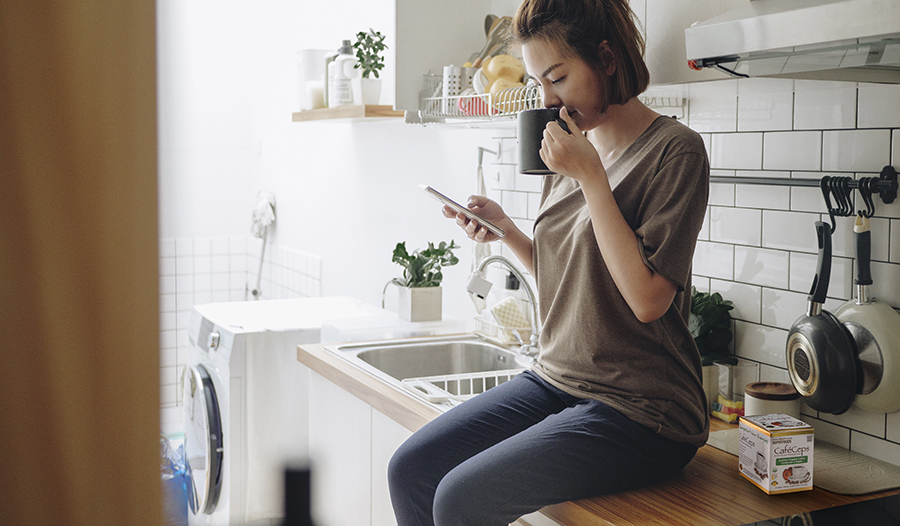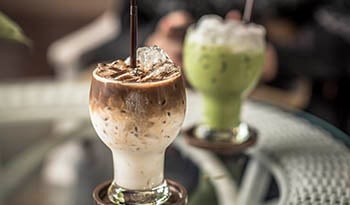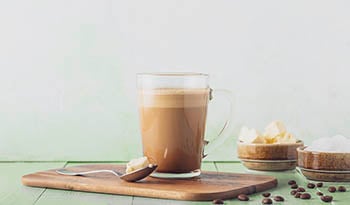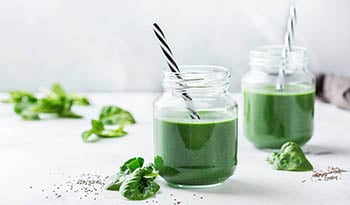7 Healthy Coffee Alternatives That Won’t Give You the Jitters
DISCLAIMER:This blog does not intend to provide diagnosis...
- In this article:
- Types of Coffee
- Health Benefits of Coffee
- How Much Caffeine Is in Coffee?
- Healthy Alternatives to Coffee

Coffee has become an everyday staple in most households. With the variety of flavors, roasts, and blends, it has become so easy to find something to suit every taste. Not only are there a variety of taste profiles available, but also tons of ways to make coffee in your home, making it even easier to access.
But, is coffee all that it’s hyped up to be? Are there any negatives, and how do you choose something different if coffee isn’t your go-to morning drink? There are many reasons why someone may want to limit or avoid coffee. This article will teach you about coffee and other alternatives to your morning cup of Joe.
Types of Coffee
First let’s start with the age-old question, what exactly is coffee? A lot of us drink it, but how many of us really know what it is? Coffee is brewed from the beans of the coffee plant that is native to Ethiopia but also grown in many other locations such as Africa, Asia, Central America, and South America. Coffee grows best in these areas because of the subtropical climates. Coffee beans vary in size, shape, and flavor depending on where they came from. Arabica and robusta are the two most common types of coffee.
- Arabica has a mild flavor. This type of bean is grown at higher altitudes and is typically lower in caffeine. Nearly 70% of the world’s coffee production comes from arabica beans.
- Robusta is used mostly in coffee blends and in instant coffee and is more cost-effective to grow. In comparison, this bean has a higher caffeine content and a more bitter taste.
Along with the common types of coffee, there are different ways coffee beans can be prepared for brewing. First, the beans must be roasted with dry heat. This roasting can range from light, medium, and dark roasts.
- Light roast coffee is roasted for the shortest time and is usually more acidic.
- Medium roast coffee is slightly sweeter than light roasted and has a balance of flavor and acidity. This roast is the most common.
- Dark roast coffee is made from lower-quality beans and typically has a stronger flavor.
Health Benefits of Coffee
Coffee does provide some potential health benefits, but keep in mind that these benefits may be available from other sources as well. Improving energy levels is one of coffee’s claims to fame. The stimulant caffeine is the most used psychoactive substance in the world. Caffeine may improve memory, mood, and energy levels. Besides caffeine, coffee has many B vitamins per cup as well.
Though coffee provides some health benefits, there are some downfalls to drinking coffee as well. Caffeine can become addictive, and for those who are dependent on it, missing a morning cup may cause headaches and irritability. Caffeine may also cause undesirable effects such as anxiety, insomnia, digestive issues, and high blood pressure.
How Much Caffeine Is in Coffee?
One of the main reasons people love drinking coffee is the caffeine boost it provides. Different coffee beans produce different amounts of caffeine, but in general, an 8-ounce cup of coffee provides 95 milligrams (mg) of caffeine. Up to 400mg of caffeine per day is considered safe for most adults, however, a person’s sensitivity to caffeine may change the tolerable amount. For those who are pregnant or breastfeeding it’s usually suggested to limit caffeine intake. Others may want to limit caffeine intake for a variety of reasons.
Healthy Alternatives to Coffee
There are so many alternatives to a morning cup of coffee. From mushroom coffee and decaf teas to matcha, there is surely something for everyone. If you’re trying to reduce coffee intake, here are some options you might enjoy.
1. Mushroom Coffee
Mushroom coffee may be a great option for those looking for a beverage with nutritional benefits. Coffees made with mushrooms may contain caffeine, but it is usually lower than a traditional cup of coffee. Some varieties, such as mushroom hot cocoa, are available for a complete caffeine-free option as well.
Mushroom coffee is made by using dried mushrooms and extracting the compounds from the mushrooms. Typically it can be found in pre-blended powders.
2. Decaffeinated Tea or Coffee
When trying to avoid or limit caffeine, decaffeinated coffee or decaffeinated tea may be a good option. In order for a beverage to be classified as decaf, 97% of the caffeine must be removed. The process to brew a decaffeinated batch is similar to caffeine-containing coffee. One cup of decaf coffee has around 2mg of caffeine. Look for a label that says decaf or check under the nutrition facts panel for total caffeine content. Not all tea is decaffeinated—black tea and green tea both contain caffeine—but there are many varieties that do not, like many herbal teas.
3. Chai
Oftentimes chai is written as “chai tea” but the word chai literally means tea! This is a type of black tea that has strong flavors. It is not caffeine-free, but it does provide less than a traditional cup of coffee. One cup of chai contains around 50mg of caffeine along with some nutritional benefits as well. It’s important to note, though, that some varieties of chai that are sold are decaffeinated, so if you like the taste but not the caffeine, they are worth seeking out.
4. Matcha
Matcha is a form of green tea that is grown without direct sunlight. After the tea leaves are ready to be harvested, the leaves are ground up into a fine, bright green powder. Matcha typically has more caffeine than regular green tea but also has more nutrients as it uses the whole leaf. One of the main health benefits of matcha is the antioxidant properties that it provides. Antioxidants are important to include in your diet as they help keep your cells healthy.
When purchasing matcha, it’s important to buy from a trusted source. Depending on the growing conditions, it may have exposure to pesticides or unsafe chemicals.
5. Yerba Mate
Traditional to South America, yerba mate has been gaining popularity in the United States. Yerba mate is an herbal tea that has a similar caffeine content to coffee. One cup of yerba mate has about 80mg of caffeine.
If adding yerba mate into your diet, consult with your doctor first. Some studies have shown a potential medication interaction with some antidepressants, muscle relaxers, and Parkinson’s disease medications.
6. Golden Milk
It’s not quite coffee but still feels like a hug in a cup. This is a completely caffeine-free beverage that is made from either dairy or non-dairy milk and spices such as turmeric and cinnamon. Golden milk originated in India and may also be referred to as turmeric milk. You can prepare this delicious drink from scratch or use a turmeric milk spice mix. Not only is this drink caffeine-free but it is also high in nutrients with no risk of dependency and fewer unwanted side effects. When drinking turmeric milk, keep in mind that the yellow color main stain clothing or towels.
7. Lemon Water
We could probably all benefit from drinking more water. On average, healthy individuals should aim to drink half of their body weight in ounces. Instead of having a hot cup of coffee try hot lemon water instead. Water is a great low-calorie and caffeine-free drink. Drinking lemon water also increases vitamin C intake. To mix it up, try adding a variety of other fruits or herbs to hot water as a coffee alternative.
Caffeine isn’t for everyone and that’s okay. With all these alternatives to coffee finding a warm drink to cozy up with is easier. Using alternatives to coffee can reduce the risk of high blood pressure, caffeine withdrawal, and even dental staining. Opting for a coffee alternative can still provide health benefits without causing dependency on a morning beverage. Be mindful of the other add-ins that go into coffee like cream and sugar. Those could be a hidden source of extra energy your body may or may not need.
References:
- National Coffee Association. NCA. (n.d.). https://www.ncausa.org/About-Coffee/What-is-Coffee.
- James, J. E. (1997). Understanding caffeine: A biobehavioral analysis. Sage Publications, Inc.
- Ferré S. (2008). An update on the mechanisms of the psychostimulant effects of caffeine. Journal of neurochemistry, 105(4), 1067–1079. https://doi.org/10.1111/j.1471-4159.2007.05196.x
- Watson, E. J., Coates, A. M., Kohler, M., & Banks, S. (2016). Caffeine Consumption and Sleep Quality in Australian Adults. Nutrients, 8(8), 479. https://doi.org/10.3390/nu8080479
- Heck, C. I., & de Mejia, E. G. (2007). Yerba Mate Tea (Ilex paraguariensis): a comprehensive review on chemistry, health implications, and technological considerations. Journal of food science, 72(9), R138–R151. https://doi.org/10.1111/j.1750-3841.2007.00535.x
- Carman, A. J., Dacks, P. A., Lane, R. F., Shineman, D. W., & Fillit, H. M. (2014). Current evidence for the use of coffee and caffeine to prevent age-related cognitive decline and Alzheimer's disease. The journal of nutrition, health & aging, 18(4), 383–392. https://doi.org/10.1007/s12603-014-0021-7

 By Rhyan Geiger, RDN
By Rhyan Geiger, RDN


